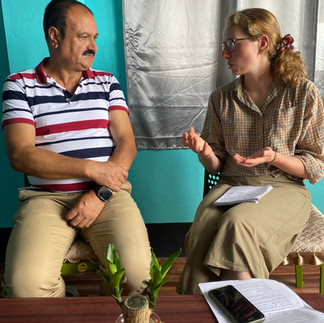7. Field trip to the Eastern Himalaya
- lottaschultz
- Jun 19
- 12 min read
Updated: Jun 20
To explore the potential for Nepal's first OECM (read more about the research background of my trip ➡️ here), I travelled from Kathmandu to Birtamod in Jhapa District, eastern Nepal, near the Indian border. In Birtamod, I met up with Wang Chu—conservationist, field coordinator with the Red Panda Network (RPN), and, very importantly, my translator and helping hand for everything for the coming days. We stopped in the small town Fikal for lunch and some quick planning discussions before starting our trip north. After three very bumpy hours by jeep, we reached our first destination: the remote village Thomke, a tiny settlement of eight scattered households located in the lower parts of dense montane temperate forest. The montane forests in this region span a steep elevational gradient, from around 2,500 to 4,000 meters. They were once government-managed national forests, but over the years, under that system, they got heavily degraded due to intense agriculture and livestock grazing. That not only led to highly fragmented habitat for species like the red panda, but also created major problems for the people living there—water shortages, the loss of important (e.g., medicinal) native plants and trees,..
A few years ago, these forests were handed over to the local communities—people who actually live in and rely on the land. Now, each so called community forest is managed by a local committee, usually led by a chairperson from the area who organizes reforestation and conservation activities. The Red Panda Network works closely with these communities to restore the forests to their native state and monitor wildlife, mostly through camera trapping. This conservation model has already, for many, created an additional source of income in a region where many families live in poverty and rely almost entirely on livestock and subsistence farming. People are, for instance, work in the area management process, planting trees, taking care of the seedlings, building fences that keep out the grazing cows from restoration sites, monitoring wildlife, and have recently started guiding ecotourism treks.
We spent our first night at the home of Dara, Thirta, and their son Robin, who recently opened a small homestay with four beds on their goat and cattle farm. Their house is located at around 2,300 meters in the middle of dense temperate forest. It is a simple, but incredibly warm and welcoming place. Over cups of chai with fresh milk from their cows, we talked about how they see biodiversity, their cultural connection to the land, the forest products they rely on, and how they feel about conservation and restoration in the area. They spoke about the changes they have witnessed since the conservation work began—how the forest feels different now, how the services it provides have slowly become more visible and appreciated. They especially highlighted the aesthetic and economic value of a healthy forest and shared their hopes that, as wildlife continues to return, more people will visit the area and stay at their homestay.
Later that afternoon, we hiked further uphill to visit two more farms. The stories we heard were similar. Life here is very tough —when you rely only on livestock. But even so, people were generally supportive of the forest restoration work. Most spoke from an economic point of view: a healthy forest means increase of the charismatic red panda, and that brings recognition, visitors, and income. One farmer shared a particularly interesting story about how he learned ecosystem value the hard way. About thirty years ago, he heard that pine trees were fast-growing and good for timber and firewood. So he planted them for just 5 NPR (0.04 cent) per tree. They did grow quickly, but also became a big problem. The pines spread, sucked up water, and completely replaced native species like bamboo on his land. Bamboo is a very important plant here, since it is not only the favourite food of red pandas but also a very valuable resource for the locals, which they have always used for building houses, making tools, and also (very delicious) food out of fermented bamboo sprouts. Wang Chu later explained that this issue is not unique to this particular area. Pine was widely planted during British colonial times across the border in Darjeeling (India) for tea packaging, and it has spread ever since. Some farmers planted it intentionally, some forests were colonized naturally. But in both cases, it is a major problem for native biodiversity.
The next morning, we started our hike up to our second site, Lamey Dhura. On the way, we took our time for birdwatching and listening. We spotted pheasants, magpies, warblers, bulbuls, and many more, and Wang Chu told stories about the landscape, the people, and the many challenges of conservation work in places like this. Around lunchtime, we reached Dawa and Pema’s place—a small teashop right at the Indian border which would be our home for the next couple of days.
Lamey Dhura is currently one of the main areas where reforestation work is happening. The area has been heavily affected by overgrazing over the years, and many native species have disappeared and been replaced by open scrubland. Walking through this landscape, you really get a sense of what habitat fragmentation looks like. Scattered patches of montane forest, broken up by vast stretches of open land. For red pandas, this is a real problem. They rely on bamboo for food, and tall trees like oak, magnolia, and maple for cover—but they won’t move through open areas. Fragmentation like this can isolate populations, lead to inbreeding and genetic bottlenecks, and eventually cause populations to decline. The restoration work here is trying to reconnect those habitat patches—to rebuild corridors of native montane forests—while still making sure that local people can continue to live, farm, and use forest resources in a sustainable way. This is a very difficult balancing act, and I think here, for the first time, I really understood how layered and complex conservation work can be.





That afternoon, we walked through one of the reforestation sites inside a community forest, checking the progress of planting and fencing, and checked some camera traps for wildlife (two half-photographed red pandas 🎉). Along the way, we interviewed local workers, forest committee chairs and their secretaries, shop owners, herders, and farmers—asking about their thoughts on conservation, challenges, benefits, their cultural connection to the land, and how they feel about the idea of designating the area as an OECM.
We also talked about their views on cross-border cooperation—since most people here live right on the line between Nepal and India, and know firsthand about the political but also cultural differences on either side. I think what stood out most for me was how varied the responses were. Some were very positive, especially about the potential for more tourism driven by red panda and a recovering ecosystem (mountain slopes of blooming rhododendron rightfully attract many people in Nepal). Others were more sceptical. Often, the reason for this scepticism is the conservation approach just across the border in India, where there is a very strictly protected area—controlled by the military. There, locals are not allowed to enter the area or use any forest resources. For many people living here on the Nepali side, that’s the closest example of strict “biodiversity conservation” and they want to prevent by all means that this is happening to their land.
Actually, this transboundary situation is interesting (and complicated) in many ways. On one hand, it has created new ecological problems. In this strictly protected area Bamboo, for example, is overgrowing because locals are no longer allowed to harvest it. At the same time, red panda numbers remain low there, possibly because parts of the forest lack the diversity of tall, broadleaf trees mixed with bamboo that red pandas prefer. On the other hand, the strict protection has also created tensions between Indian and Nepali communities. Some Indian locals cross into Nepal to collect limited forest resources and also poaching has been reported, which stirs up transboundary human conflicts.
There was a lot of talking, learning, and observing during those days in Lamey dhura, but two interviews especially stuck with me.
The first was with Dawa, mother of two kids and the woman running the teashop together with her husband where we stayed for three nights. Their place is incredibly remote—with limited electricity, no mobile signal, and no warm water. She told us that they used to have more livestock, but with the conservation efforts in the area, they shifted to running just the teashop and renting out two small rooms. It was a very honest (and emotional) conversation. She said she actually can’t wait for rhododendrons to bloom or red pandas to return to attract tourists to come and visit the area, as their current income is not nearly enough to live on or cover school fees for the kids. She also stressed how much of a difference better road infrastructure could make—not only for tourism, but for access to schools and hospitals. And the contrast across the border is really striking: on the Indian side, roads are well-developed while on the Nepali side, there are still only footpaths connecting villages like hers to the next towns.
The second was a farmer who also works part-time with RPN, doing wildlife monitoring. He told us he is slowly reducing his livestock and grazing area and he sees how his animals have contributed to some of the ecological problems the area is facing. But at the same time, he shared that he often feels left out—farming is all he knows, and starting something new is not easy when you don’t have resources or education. He also has two kids (I met his daughter, she is about my age), and his current income from farming and part-time conservation work just isn’t enough for the family. He talked about the tension he feels—on one hand, he wants to help restore the landscape, but on the other, he’s experiencing firsthand the challenges that the newly restored forests create for his livestock.
…just a short part of two out of so many stories and perspectives we heard that day…

The next early morning, we visited some of the wildlife monitoring transects. The concept for this kind of monitoring is to search systematically (in addition to the camera traps) for signs of red panda and other large mammals in certain plots of area. Apart from some (very fresh) red panda poo and scratch marks on a tree—no luck this time. Later, we hiked to a plant “nursery station” where native plants (Himalayan birch, wild kiwi, bamboo, different rhododendron varieties, thick-leaved oak, and more) are grown until strong enough to be planted back into the wild. After that, we continued to another reforestation site, always scanning for wildlife, listening for birds, and checking fences and the growth of the newly planted trees.

By the end of the day, after hours of hiking and dozens of conversations, we ended up back at Dawa and Pema’s teashop. On the way, we found some wild rhubarb out of which I tried to make my favorite rhubarb crumble for our hosts—but without an oven, it turned into more of a rhubarb-flavored Austrian Kaiserschmarrn. I was slightly disappointed, but everyone else loved it. In return, Dawa showed me how to make an incredible dal bhat side dish using wild fern, garlic, and spices. So many moments—these days full of unforgettable impressions and memories, with the most amazing, warm, and fun people (even with most times major language barrier 😉).
After a traditional Buddhist goodbye ceremony—where you are given a scarf with prayers and warm wishes—we continued our journey to the next restoration sites near Tumling. Along the way, we kept checking the camera traps and fences. As we reached higher elevations and the clouds lifted a bit (we were somewhere around 3,200 meters I think), we had an incredible view of Mount Kanchenjunga—the third highest peak in the world at 8,586 meters. We didn’t meet anyone but plenty of leeches (Blutegel for my German-speaking friends) along the trail.
When we arrived in Tumling (a slightly bigger village with around 20 households) we stayed at another homestay, this time hosted by Neela. Neela is an Indigenous woman from the Gurung community. About 20 years ago, completely on her own initiative, she started restoring parts of the landscape around the village. And after years of unsuccessful talks with local government about road development, she took things into her own hands and organized a group of friends to build a new road through the village themselves. She told us how much she cares about this landscape, how she watched it change over her lifetime, and how some bird and insect species have started moving higher up to 1000s of m into the area around Tumling. She also spoke about the growing awareness in the village—how more and more people are coming together to protect their land and work toward biodiversity conservation.
From Tumling, we continued on to Jaubari. The landscape up here was just stunning—and again, it clearly showed how fragmented the habitat still is for wildlife. You see patches of older, restored native forest, but they are fragmented by lots of open land where restoration work is only just beginning. More than 90% of the villagers and settlements around Jaubari (n = 50 or so 😉) are involved in the restoration work here. When we arrived, Wang Chu showed me the “older” parts of the community forest that were successfully restored years ago and explained the future plans to connect the scattered habitat patches over the coming years.
After that, we went to check and replace some old camera traps. To get there, we hiked through stunningly dense montane forest with high bamboo and beautiful magnolias, hearing a huge variety of bird sounds. One of the camera traps was particularly exciting—it had just captured a huge leopard, photographed only very shortly before we got there.
Later, we visited the research plots near Jaubari where different planting setups are being tested—like how various species respond to different spacing, slope directions, and planting combinations. I helped plant trees while chatting with the locals and got to hear some of their reactions to our exciting leopard “sighting.” People told us that the habitat restoration has definitely been successful so far—there’s a clear increase in large mammals in the area. Which, of course, is great news for conservation. But for the local people, it also means more conflict. Leopards are preying on goats and cattle, and some are now scared to go into the forest to harvest bamboo or other plants. We heard lots of different ideas (some more serious than others) about how to handle it—from relocating leopards to fencing off the villages. But overall, despite these challenges, people here still seem to be very confident that conservation can improve their livelihoods in the long run.
Around Jaubari, there is a diverse mix of ethnic communities (e.g., Sherpa, Gurung, Chettri, Brahman, Limbu, and more) and many cultural sites like monasteries and sacred trees. People here are deeply connected to the landscape through their traditions. Worshiping nature is the core part of their culture, and many emphasized how important it is to protect both the land from degradation and their cultural sites from being forgotten or lost. After a long day in the field we headed back to our homestay for the next two nights. That evening, I levelled up my Nepali cooking skills by learning how to prepare, fill, and fold momos (Nepali dumplings).
From Jaubari, we took another bumpy jeep ride down to the town of Ilam, which is famous for its tea plantations. The reason for our visit was to conduct interviews with local government representatives. Honestly, I had started this trip just hoping to get a general sense of the area and hear what people think about biodiversity conservation and the idea of OECMs. But thanks to the never-ending helpfulness of people in Nepal—especially Wang Chu and his local partners—I suddenly found myself (in full field clothes) sitting in the government offices of eastern Nepal. They had somehow arranged official meetings with the mayor of Ilam, the mayor and vice-mayor of Sundakphur Municipality (in a neighboring district), officials from the Division Forest Office, and several other local partners and stakeholders. It all felt a bit surreal (and definitely out of my comfort zone at first) but the conversations turned out to be really nice. Everyone was super approachable and took time for us even a government meeting in Ilam was paused so we could have our talk. It was really interesting to hear how the officials view the potential and the challenges of conservation, and to get their perspectives on what OECMs could mean for their region.
After that slightly different kind of day, we headed the next morning to our final stop: Pathenagi. This was the highest site we visited, at around 3,500 meters. The landscape here is apparently stunning, with steep mountain slopes and views but unfortunately, that day it was rainy and foggy, so we didn’t get to see much. Still, we went for a nice (wet) hike to do our usual tasks, checking fences and cameras, having conversations with people. Pathenagi is home to one of the oldest community forests in the region, and the sense of awareness about the value of biodiversity is really strong here. It’s also very diverse culturally, with many Indigenous communities who live in close connection with nature and traditional practices, for example, through their use of medicinal plants.
As the monsoon rain got heavier, we hiked down to a small, isolated farmhouse owned by a 26-year-old guy who’s running the place all on his own. We warmed up around his fire, snacking on homegrown potatoes and chatting about his plans for the future. Later that evening, we took a jeep ride back to Ilam for my last night in the east.
All in all, it was an incredible experience. Being out in this landscape—seeing and hearing the real-life challenges of mountain conservation, talking to so many people, listening to so many stories. It was really moving, and sometimes, honestly a lot to take in. On one hand, I learned so much. But on the other, I left with just as many open questions and a sense of the challenges in balancing biodiversity conservation with improving the livelihoods of people, here, and in so many other parts of the world facing similar issues.
It will definitely take some time to process everything. But over the next few days, I will sit down with all the interviews and start summarizing everything I’ve seen, heard, and learned.














































































Comments